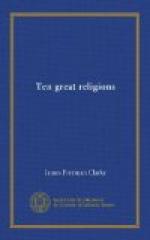Father Hue, in his “Christianity in China,” says that “the Europeans who penetrated into China were no less struck with the libraries of the Chinese than with their artillery. They were astonished at the sight of the elegant books printed rapidly upon a pliant, silky paper by means of wooden blocks. The first edition of the classical works printed in China appeared in 958, five hundred years before the invention of Gutenberg. The missionaries had, doubtless, often been busied in their convents with the laborious work of copying manuscript books, and the simple Chinese method of printing must have particularly attracted their attention. Many other marvellous productions were noticed, such as silk, porcelain, playing-cards, spectacles, and other products of art and industry unknown in Europe. They brought back these new ideas to Europe; ’and from that time,’ says Abel Remusat, ’the West began to hold in due esteem the most beautiful, the most populous, and the most anciently civilized of all the four quarters of the world. The arts, the religious faith, and the languages of its people were studied, and it was even proposed to establish a professorship for the Tartar language in the University of Paris. The world seemed to open towards the East; geography made immense strides, and ardor for discovery opened a new vent for the adventurous spirit of the Europeans. As our own hemisphere became better known, the idea of another ceased to appear a wholly improbable paradox; and in seeking the Zipangon of Marco Polo, Christopher Columbus discovered the New World.’”
The first aspect of China produces that impression on the mind which we call the grotesque. This is merely because the customs of this singular nation are so opposite to our own. They seem morally, no less than physically, our antipodes. Their habits are as opposite to ours as the direction of their bodies. We stand feet to feet in everything. In boxing the compass they say “westnorth” instead of northwest, “eastsouth” instead of southeast, and their compass-needle points south instead of north. Their soldiers wear quilted petticoats, satin boots, and bead necklaces, carry umbrellas and fans, and go to a night attack with lanterns in their hands, being more afraid of the dark than




